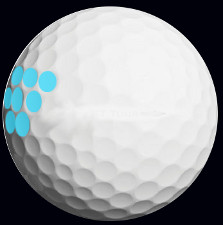
Dimple
In the world of golf, the term “dimple” refers to the small indentations found on the surface of a golf ball. These tiny depressions play a significant role in the flight and performance of the ball. Let's explore the importance of dimples in golf and how they affect the game.
- Aerodynamics: The primary function of dimples is to enhance the aerodynamics of a golf ball. When a golf ball is in motion, it experiences air resistance or drag. The dimples on the ball's surface alter this airflow by creating a turbulent boundary layer of air around the ball. This turbulent layer, also known as the “boundary layer separation,” reduces the drag on the ball and allows it to travel farther through the air.
- Lift and Spin: Dimples also play a vital role in generating lift and controlling spin. When a golf ball is struck with a club, it imparts both backspin and sidespin. The dimples on the ball's surface create lift by causing the air pressure on the top of the ball to be lower than the air pressure on the bottom. This lift helps the ball to stay airborne for longer distances. Furthermore, the dimples also influence the amount of spin on the ball. The backspin created by the clubface interacting with the dimples helps the ball maintain stability and accuracy during flight.
- Types of Dimples: Dimples on golf balls come in various patterns and depths. Different manufacturers incorporate their own unique dimple designs to optimize the ball's performance. Some common dimple patterns include circular, hexagonal, and elliptical. These patterns are strategically engineered to control the airflow around the ball and achieve the desired flight characteristics.
- The Rule of Dimples: The United States Golf Association (USGA) and the Royal & Ancient (R&A) govern the rules and regulations of golf. According to their guidelines, a regulation golf ball must have a minimum of 300 dimples. Additionally, the depth and diameter of the dimples must conform to certain specifications.
- Evolution of Dimples: Over the years, the design and technology behind golf ball dimples have undergone significant advancements. Golf ball manufacturers continually innovate to create more efficient and effective dimple patterns. The evolution of dimples has led to improved distance, accuracy, and overall performance of golf balls.
In conclusion, the dimples on a golf ball are not merely aesthetic features but crucial elements that impact flight, distance, lift, and spin. These small indentations enhance the aerodynamic properties of the ball, reduce drag, and provide stability during flight. The different patterns and depths of dimples allow manufacturers to fine-tune the performance of golf balls. Understanding the significance of dimples can help golfers make informed decisions when selecting the right ball for their game.





